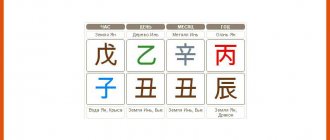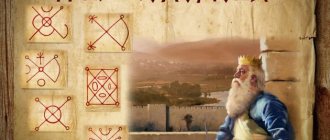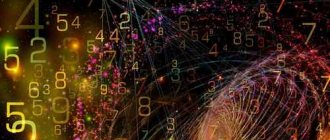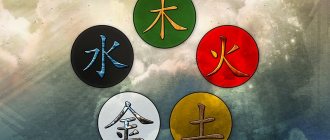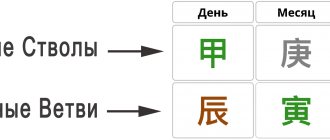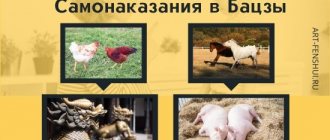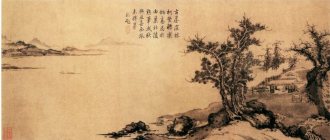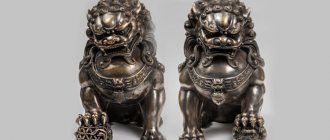Celestial trunks are cyclic signs of the decimal cycle.
Used in conjunction with the duodecimal signs - the Earthly Branches, also known as the 12 animals of the Chinese calendar. Most often, the joint use of two cycles of calculation is explained as a symbol of the interaction of yin and yang, Heaven and Earth. Figuratively, one can call the manifestation of the influence of the heavenly trunks an intangible component - “the will of heaven.” They represent a manifestation of energy in the five elements, each of which has two properties - Yin and Yang. While the Earthly branches are the material manifestation of these energies.
| № | Sign | Pinyin | Transcription | Five elements | Five directions | Yin and Yang |
| 1 | jiǎ | Jia | 木 Tree | 东 East | 阳 Yang | |
| 2 | yǐ | AND | 阴 Yin | |||
| 3 | bǐng | Bean | 火 Fire | South | 阳 Yang | |
| 4 | dīng | Dean | 阴 Yin | |||
| 5 | wù | U | 土 Earth | 中 Center | 阳 Yang | |
| 6 | jǐ | Ji | 阴 Yin | |||
| 7 | gēng | Geng | Metal | West | 阳 Yang | |
| 8 | xīn | Xin | 阴 Yin | |||
| 9 | ren | Ren | Water | North | 阳 Yang | |
| 10 | guǐ | Gui | 阴 Yin |
It should be taken into account that the influence of the elements is cyclical relative to the seasons. Here, seasons refer to the decades of seasons according to the solar Chinese calendar of agricultural seasons.
. At the same time, the element of Earth (Soil) dominates in the third month of each season.
| Metal | Tree | Water | Fire | |
| Spring | dying | prosperity | weakening | origin |
| Summer | origin | weakening | dying | prosperity |
| Autumn | prosperity | dying | origin | weakening |
| Winter | weakening | origin | prosperity | dying |
Heavenly trunks 甲 (JYA) and 乙 (Yi) elements 木 Tree
The element Tree is represented by two Heavenly trunks: JIA, I. More about the element Tree Earthly branches, which represent the Heavenly trunks of the Tree element: YIN, MAO. Trunks in branches: YIN, MAO, CHEN, HAI, WEI. According to the cycle of generation and overcoming (control): Water gives birth to Wood, Wood gives birth to Fire. Metal overcomes/controls Wood, Wood overcomes Soil.
甲 (CZYA) - Yang Tree
The tree of the TZYA sign is a Yang Tree.
Represents beams and rafters. It is defined as dead, hard Wood. Its roots have already been cut off and its branches have already been cut off. Therefore, in order to prepare utensils from it, it is necessary to chop it with a sharp ax. Interestingly, the character 甲 (CZYA) also has the meaning “main” or “first”, which is directly related to the Chinese calendar. And besides, it means “carapace, armor, armor, armor.”
乙 (I) - Yin Tree
The tree of the Yi sign is in order after the JZYA sign.
It develops and nourishes everything that exists, without ceasing, it gives birth to life. This is a Yin Tree. It is called a living tree. The I sign tree enters the career stage in the MAO sign. In addition to the meaning of the term in Chinese metaphysics, the character 乙 (Yi) has the meaning “second in order”, as well as “swallow”.
Academy of Metaphysics Victoria Baykova
If you have been studying Chinese forecasting techniques for some time, you could not ignore one of the fundamental theories - the theory of the trinity of Heaven, Earth and Man. According to the ideas of Chinese culture, everything that exists consists of three principles: Heaven, Man and Earth. The concept of the Cosmic Trinity describes their mutual influence and is manifested in the interaction of three types of energy: qi of heaven, qi of earth and qi of man .
Thus, in the human body, three parts are initially distinguished (upper, middle and lower), and in each of these parts the region of Heaven, Earth and Man. At the bottom, the Heaven region is used to determine the condition of the liver, the Earth region is used to determine the condition of the kidneys, and the Human region is used to determine the condition of the spleen. In the middle part of the human body, the Heaven region is used to determine the condition of the lungs, the Earth region is used to determine the condition of the chest as a whole, and the Human region is used to determine the condition of the heart. In the upper part of the human body, the Sky region is used to determine the energy state in the temporal region of the forehead, the Earth region is used to determine the energy state of the mouth and teeth, and the Human region is used to determine the energy state of the ears and eyes.
The three-level structure is also fixed in the symbolism of trigrams, where the first level (bottom) is the level of the Earth, reflecting all the processes occurring on its surface. The third level (upper) is the level of the Sky, reflecting the movement of Celestial bodies and weather changes. And finally, the middle level is the level of Man, who must follow the laws of Heaven and Earth.
In relation to Ba Zi, it is believed that the energy of Heaven is carried out by the Heavenly trunks. The Earth's energy is carried out by the Earth's branches. As for the Human principle, it is represented by the Heavenly trunks hidden in the Earthly branches. In each of the twelve Earthly branches there are hidden Heavenly trunks. We will talk about their nature and some properties below.
List of Heavenly trunks hidden in Earthly branches:
If we carefully look at the table, we will see that inside some Earthly branches one Heavenly trunk is hidden, inside others there are two or even three Heavenly trunks. For example, in the Rat (yav) we will find only Water (iv), since the Rat (yav) is pure Water. In the Rabbit (id) there is only one Heavenly Tree trunk (id). However, if we look at the Bull (from), we will see that the Heavenly trunks of Metal (from), Earth (from) and Water (willows) are hidden in it. Why is this happening?
The fact is that each of the elements (except for the Soil) lives through three main phases of life :
All animals, based on how they are located in the table, can be divided into three groups. The first group is animals in which elements are born. The second - in which they reach the maximum of their strength and the third - in which they are very weak (in which they are preserved).
Rat is the strongest Water, so it is a pure element and nothing else can be there. The Rooster is the strongest Metal, so like the Rat, it is a pure Metal element, similarly, the Rabbit has only Wood. The exception is the Horse. Despite the fact that it represents the strongest element of Fire, in the summer another element, Earth, also reaches its maximum, because it is Fire (the element of Summer) that it is supported by. Therefore, the Earth can also be found in the Horse.
The remaining Eight Animals are more complex. So the Tiger is the birthplace of Fire, therefore it contains Fire, but it itself is a Tree and comes in Spring, in the season of the Tree, therefore it also contains a Tree. Since Fire and Earth share one life cycle, then together with Fire the Tree is born, hence, together with Fire in the Tiger we find the Earth. And so on.
What are the hidden Heavenly Stems ? Let's look at some meanings.
Firstly, as should be clear from all the above discussions, the hidden Heavenly trunks are the human principle that provides the connection between the Heavenly energy, represented by the Heavenly trunks, and the Earthly energy, represented by the Earthly branches . It is through the hidden Heavenly trunks that the Earthly branch of the month in the Ba Zi layout communicates with the element of personality. This factor is used in particular when carrying out structural analysis in Ba Zi.
Another area of application of the Heavenly trunks hidden in the Earthly branches is the analysis of Houses in Ba Zi layouts. For example, when analyzing the Pillars of Destiny, we look at the House of the spouse. What can we see in the hidden trunks?
For example, a woman has the Earthly branch of Shen (Yam) or Monkey in her husband’s House. However, Monkey is not just Metal. It contains the Heavenly trunks Wu (yaz), Gen (yam), Ren (yav). Hidden trunks in this case will speak about the character, or, more precisely, about the quality, of her husband. In this case, since for a woman with a Yang Fire personality element, Earth is Self-Expression, Metal is Money, Water is Power. Based on all of the above, we can say that the husband of this woman will be a powerful person, or at least have good administrative abilities, will have money and women (since for a man they seem to be one element) and, in addition, he will be smart (self-expression, most often , speaks about the level of intelligence).
However, I should note that this interpretation of the hidden Heavenly trunks is not entirely accurate, since much depends on the strength of the card in question and the favorableness of the elements. For this reason, I would not recommend that you attach much importance to such interpretations.
Another meaning of the hidden Heavenly trunks that is directly related to Ba Zi is that with their help it is determined whether the manifested Heavenly trunks in the map have roots in the Earthly branches . This factor plays an important role in determining the strength of a personality element.
In the table below of the Four Pillars, in the birthday trunk we see the Heavenly trunk 甲 Jia. We also see this same trunk, 甲 Jia, in the hidden Trunks of the Earthly branch of the month 寅 Yin. In this case, we say that 甲 Jia has roots. This can be compared to a Tree having roots.
Heavenly trunks 丙 (BIN) and 丁 (DING) elements 火 Fire
The element Fire is represented by two Heavenly trunks: BIN, DIN. Read more about the element Fire. Earthly branches: Sy, U. These Heavenly Stems are also present in the branches: Si, Wu, Wei, Yin, Xu. According to the cycle of generation and overcoming (control): Fire is generated by Wood, generates Soil, is overcome by Water, overcomes Metal.
丙 (BIN) - Yang Fire
The fire of the BIN sign burns in the center of Heaven, it illuminates all six limits with its light. In Heaven it corresponds to the Sun and lightning, on Earth it corresponds to the furnace and smelter. It is defined as dead Fire, the Fire of death. His career falls in the sign Sy. He loves the dead Tree of the Chia sign, which generates his flame. Does not like Metal and Soil, which hide and extinguish his light.
丁 (DIN) - Yin Fire
The Fire of the DIN sign - in Heaven it corresponds to rows of stars, and on Earth it represents the Fire of the lamp.
His career falls on the U sign. When there is a Tree of the I sign inside, it is capable of generating the Fire of the DIN sign. The I sign represents a living Tree, and the DIN sign represents a living Fire. The DIN sign rejoices at the Tree of the I sign that generates it. The character 丁 also has the meaning “full-grown person, male”, as well as the meaning “cut into pieces.”
Heavenly trunks 戊 (Wu) and 己 (JI) elements 土 Earth
Heavenly trunks: Wu, Tszi. Read more about the element Earth Earthly branches: Chen, Chou, Wei, Xu. These Heavenly trunks are present in the Earthly branches: Chen, Xu, Wei, Si, Wu, Yin, Shen. According to the cycle of generation and overcoming (control): Fire generates Soil, Soil generates Metal. Tree overcomes Soil, Soil overcomes Water.
戊 (U) - Yang Soil
The soil of the sign U is a mountain. Her career falls on the sign Sy. She loves Yang Fire - this is the Fire of the BIN sign, with which they give birth to each other. She is afraid of the robber energy of Yin Metal, when the Metal is in its prime, the Soil is devastated. The character 戊 (U) also means “lowest score” (lowest grade, unit).
己 (TsZI) - Yin Soil
The soil of the TsZI sign is Yin soil.
This is the true Soil. Therefore, it is necessarily present in the other four elements, and in all four times there are periods of its flourishing. She (Soil of the sign ZI) loves the Fire of the sign DIN, which generates her. She is afraid of the Yang Fire, which dries her. Her career falls on the U sign. After all, the Fire of the DIN sign, located inside the U sign, is capable of generating the Soil of the TsZI sign. The tree of the sign And steals her energy. As for the area of the Yu sign, the Fire of the DIN sign is born there. This means that the Soil of the TsZI sign is also capable of being born. The character 己 (TsZI) also has several meanings other than astrological ones. First of all, it is the possessive pronoun “oneself; himself, personally, his own, own.” It also has a verbal meaning “to manage, to put in order, to establish.”
Our website “Fushigi Nippon - Mysterious Japan” is dedicated to the culture of Japan, Japanese art and traditions, as well as the life of ordinary Japanese. Every day we have new information about this wonderful country - articles dedicated to Japan, reviews of anime and works of famous Japanese painters, as well as recipes for Japanese cuisine and much more.
The main section of the site is articles about Japan , which covers all aspects of Japanese culture: from society and native Japanese customs to the secrets and history of Japanese cuisine and art.
More information about the “ Articles about Japan ” section:
The Geography section provides a map of Japan, describes the geographical location of the country and its administrative-territorial division.
The articles in the State are devoted to Japanese society and the problems it struggles with. the Gaijin Directory will be of undoubted interest , which lists the most necessary things: how much housing costs in Japan, how to send a child to kindergarten, how to get health insurance in Japan and much more. It will be useful to familiarize yourself with the Japanese Constitution.
The Art of Japan section contains articles on many different areas: there are articles devoted to Japanese theater and handicrafts, ikebana and bonsai, and also provides advice on the practice of Feng Shui and arranging a Japanese garden on your site. The section also contains articles dedicated to outstanding Japanese figures - directors, painters, voice actors - i.e. those who made a tangible contribution to the development of Japanese culture.
Articles in the History will tell about the hard everyday life of samurai, their training and schools, the arrangement of medieval Japanese society, the Meiji Restoration and other stages of Japanese history. The history of Japan is rich in a variety of events, which, for convenience, are presented in a separate article and presented in chronological order. The reigns of the first Japanese kings and shoguns are given.
In the Cooking you will find descriptions of such popular Japanese cuisine products as tofu, soy sauce, tuna, wasabi, daikon and others; learn how to prepare sake at home, how to eat with chopsticks and set the table in Japanese style.
The culture of Japan is very unique and often incomprehensible to residents of other countries. the Culture section are intended to eliminate barriers of misunderstanding , which will talk about relations in Japan between men and women, about the Japanese sense of beauty and beauty, about personal and public communication between Japanese, and also tell about the position of women in modern Japanese society, accepted norms of business etiquette in communicating with the Japanese and many other aspects characteristic of the residents of this particular country.
In the Literature you can get acquainted with very unique Japanese poetry (for example, haiku (hoku) and tanka), Japanese myths and legends, as well as Japanese fairy tales, sometimes sad, and sometimes completely incomprehensible to Westerners. The section also presents collections of samurai ethics: “Hagakure”, written by Yamamoto Tsunetomo, and “The Book of Five Rings”, written by the sword master Miyamoto Musashi.
The Japanese are not devout, but they are religious, and their indigenous religion, Shinto, is a unique amalgamation of animistic beliefs dating back centuries. Buddhism is also widespread in Japan, but has changed under the pressure of circumstances over time. You can read more about Shintoism and Buddhism in the Religion .
Japanese traditions and the behests of their ancestors are unshakable and are sacredly observed after many centuries: tea and wedding ceremonies are still held, and modern Japanese businessmen still honor the Code of Bushido and follow the instructions taught to young samurai. Traditions section also covers holidays celebrated in Japan.
The Japanese language is very unique and, like Chinese, is based on hieroglyphs. Japanese characters represent entire syllables, and often words at once, and can be written in several ways. The simplest way is the katakana alphabet, which is currently used for the most part to write foreign words and borrowings. More complex than katakana is hiragana, which is used to write ordinary Japanese words and is characterized by smoother lines. The language of the people is most clearly manifested in proverbs and sayings, which are presented in large numbers in the Language . Also, do not forget about non-verbal means of communication (facial expressions and gestures), which are also given attention in the articles.
There is also an Encyclopedia in which you can learn a lot of new things. For example, the encyclopedia “Male and Female Japanese Names” contains about 2000 names, and the encyclopedia “Japanese Words and Expressions” can find the meanings of many different Japanese expressions. The Japanese Gods Encyclopedia contains information about the most significant and famous gods of the Japanese pantheon, and the Japanese Cuisine Encyclopedia will provide explanations regarding the terminology of Japanese cuisine.
Japanese Cuisine section contains a large number of recipes for Japanese cuisine, for example, sushi and sashimi recipes, Japanese soup recipes, Japanese sweets recipes and many others. Most of the recipes are very simple to follow, and in terms of exoticism, Japanese cuisine is perhaps rivaled only by Chinese cuisine. The main ingredients for the dishes are a variety of seafood (tuna, shrimp, eel and, of course, fugu) and seaweed (kombu, for example), as well as, of course, rice and vegetables (daikon, beans, celery and others). Soy products are also popular - tofu and miso, and the king of products from this plant is soy sauce! Recently, the Japanese have begun to actively consume products typical of Western cuisine, but traditional culinary recipes are still loved and not forgotten, which is not surprising, because in addition to its exoticism, Japanese cuisine is the healthiest in the world, and the Japanese diet helps the indigenous people The Land of the Rising Sun will live to a very old age in good spirits and sound mind. Helpful Tips section is intended to help cooks , where you can find information on how to replace some ingredients that are unique to Japanese cuisine.
Anime Reviews section is dedicated to evaluating and discussing one of the areas of modern Japanese culture - anime. Anyone can send their review of the anime, as well as leave comments.
Origami diagrams and kusudama diagrams contain descriptions and instructions for assembling many models of origami and modular origami - a Japanese art that has gained incredible popularity throughout the world. The presented patterns have different levels of complexity and even a novice origamist can find a pattern to suit his taste and skill.
Japanese prints are very original and often very skillfully made, so the works of famous Japanese artists such as Katsushika Hokusai, Ando Hiroshige and other painters the Photo Gallery Also in the Photo Gallery you can find the creativity of our readers and photographs of modern Japan.
For communication and discussion of materials, we have a convenient Forum , the main sections of which are “Anime and Manga”, “All about Japan”, “Our Creativity”, “Culinary Duel” and “Tea House”. A variety of topics are discussed: Japanese cinema, features of Japanese cuisine, Japanese painting, anime and much more.
Heavenly trunks 庚 (GEN) and 辛 (XIN) elements 金 Metal
Heavenly trunks: GEN, XIN. More details about the element Metal Earthly branches SHEN, Yu. These Heavenly trunks are present in the Earthly branches: SHEN, YU, XU, SY, CHOU. According to the cycle of generation and overcoming (control): Metal is generated by Soil, generates Water. Overcome by Fire, overcome by Wood.
庚 (GEN) - Yang Metal
The metal of the GEN sign has the power to punish and destroy.
This is Yang Metal. He controls all changes in human space associated with the use of weapons. On Earth it takes the form of iron. He achieves a career in the sign SHEN. He loves the Soil of the U sign, which gives birth to him. He is afraid of the Water of the sign GUI, in which he drowns. It increases under the sign SY. The soil of the U sign, which is contained within the SY sign, is capable of generating the Metal of the GEN sign. It is interesting that the character 金 (Metal) itself is also used in the meanings: gold, golden (in relation to metal or color), money, payment, treasures, valuables. And since Metal corresponds to the autumn season, the hieroglyph 金 can be found in poetic lines meaning “autumn, autumnal.” The character 庚 also means “age” and “path, road.”
辛 (BLUE) - Yin Metal
The metal of the BLUE sign is an ore in a rock, it is a soft Metal.
It is defined as a Yin Metal. His career falls under the Yu sign. The soil of the TsZI sign inside the Yu sign is capable of generating the Metal of the SIN sign. The character 辛 also means “tart, sharp”, as well as “difficult, heavy”.
Heavenly trunks 壬 (REN) and 癸 (GUY) elements 水 Water
Heavenly trunks: REN, GUI. Read more about the element Water. Earthly branches: Hai, Zi. Trunks in branches: Hai, Zi, Chou, Chen, Shen. According to the cycle of generation and overcoming (control): Water is generated by Metal and generates Wood. Overcome by Soil, overcome by Fire.
壬 (REN) - Yang Water
The water of the REN sign represents autumn dew.
The water of the REN sign is born in the Shen sign. Water of the REN sign loves Yang Soil, but she is afraid of Yin Wood. She achieves a career in the sign of Hai. The character 壬 is a symbol of water as an element and a symbol of winter as a season. In addition, the character 壬 has the meaning “ingratiating, flattering” and “great, majestic.”
癸 (GUY) - Yin Water
The water of the GUY sign represents spring rains. The water sign of GUI is born in the month under the sign of Mao. It is called Yin Water. She achieves a career in the sign of Zi. The water sign dies in the Shen sign.
Interaction of Heavenly trunks
According to the Wu Xing circle of generation and control, the elements are in certain relationships with each other.
Merger
Elements that are in relation to control, but at the same time have different polarities, are subject to fusion. Therefore, each of the Yang elements merges with the controlled Yin element. Wood Yang + Earth Yin = Earth Metal Yang + Wood Yin = Metal Fire Yang + Metal Yin = Water Water Yang + Fire Yin = Wood Earth Yang + Water Yin = Fire If the fusion occurs in the ba-zi chart, then the resultant is the Heavenly Stem Yang , if it stands on the Earthly Yang branch, and the Yin Heavenly trunk if it stands on the Earthly Yin branch. If two elements participate in a Merger with the generation of an element, then these two elements are “occupied only with each other,” i.e. they do not participate in other interactions. Only opposite Heavenly trunks take part in the merger: Yang + Yin (like a boy and a girl ). The merger occurs in the direction of control/destruction, which is why it is clearly visible on the Wu-Sin diagram (and is easier to remember).
Control/suppression
: Control relationships involve elements that have the same polarity. Moreover, how successful this attempt at control/suppression will be will depend on the strength of the controller. Wood Yang -> Earth Yang Wood Yin -> Earth Yin Metal Yang -> Wood Yang Metal Yin -> Wood Yin Fire Yang -> Metal Yang Fire Yin -> Metal Yin Water Yang -> Fire Yang Water Yin -> Fire Yin Earth Yang -> Water Yang Earth Yin -> Water Yin
Collisions
: Wood Yang Metal Yang Wood Yin Metal Yin Fire Yang Water Yang Fire Yin Water Yin Heavenly trunks of only the same polarities take part in the collision: Yang Yang (or Yin Yin). The collision occurs in the control/destruction direction, i.e. for example, in the pair Yang Wood - Yang Metal, the attacking element is Yang Metal. But in a collision, the stronger element will win in this interaction. Strength or weakness is determined by the Qi Phase of the element (Phases of development of the 5 elements in the season and their designation). The table below clearly shows the dependence of the manifestation of the power of the Heavenly Stem (NS).
By what principle are hidden celestial trunks formed?
The presence of one, two or three elements in the earthly branches is explained by the life cycle of the elements:
- water is born in the Monkey, flourishes in the Rat and ends its cycle in the Dragon; - fire is born in the Tiger, flourishes in the Horse, and ends its cycle in the Dog; - the tree is born in the Pig, flourishes in the Rabbit and ends its cycle in the Goat; - metal is born in the Snake, flourishes in the Rooster, and ends its cycle in the Bull.
In the birth phase, the energy is weak, it is the seed from which the element it generates grows, and in addition, it contains the element of earth. The latter occurs because there are only five primary elements, and four seasons. Therefore, for example, the Monkey has its native element - Yang metal, the water it generates and the earth that supports it. By the same principle, the heavenly trunks are contained in the earthly branches of the Tigre, Pig and Snake.
When energy is in the prosperity phase, it is full. For example, in June there is the fire of the Horse, in September the metal of the Rooster, in January the water of the Rat, in March the tree of the Rabbit. Therefore, in the classical version, the heavenly trunks hidden in the earthly branches are designated only once, in the modern version - as yin and yang energy. Only the Horse contains earth, because in the Bazi it is believed that fire always shares a place in the cycle of elements with earth.
When energy in the grave phase completes its cycle, it becomes vulnerable, so it reveals itself, as, for example, in the case of the Dragon - water, the fifth element - earth and wood - the element of the spring period. By the same principle, the Dog contains fire, the fifth element - earth and the element of the autumn period - metal. By analogy, Ox and Goat.
